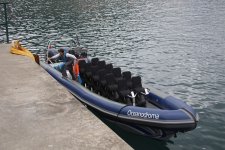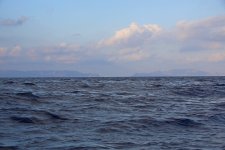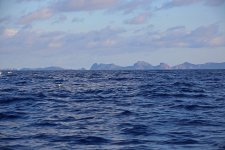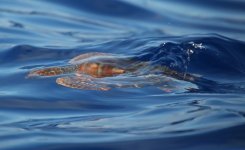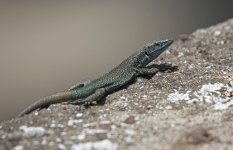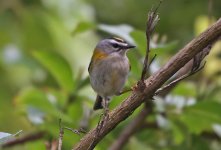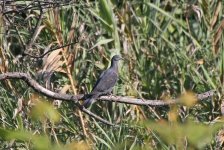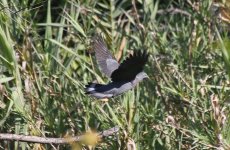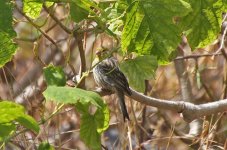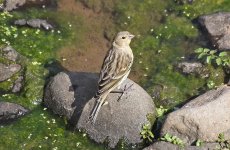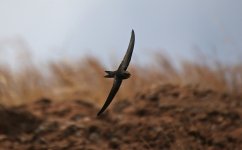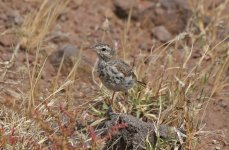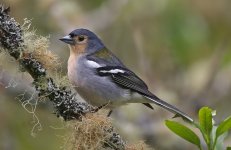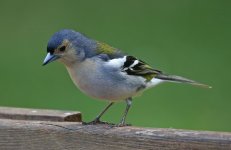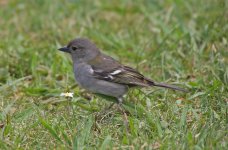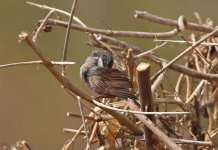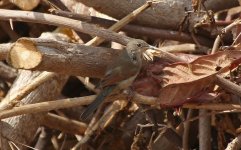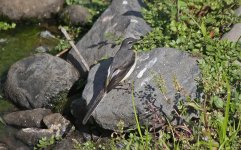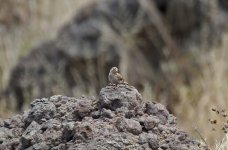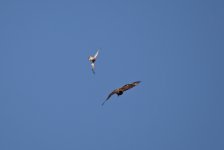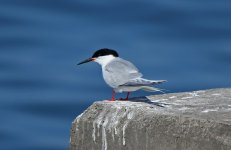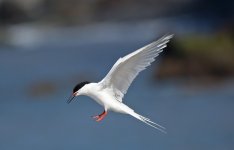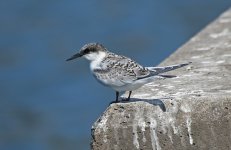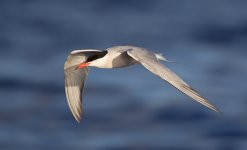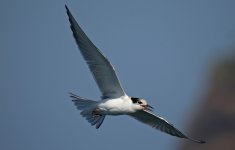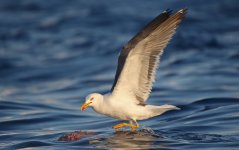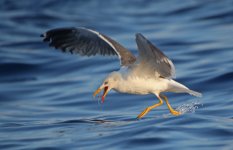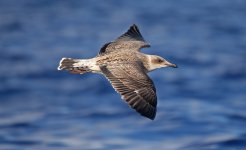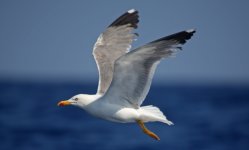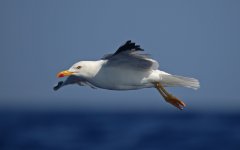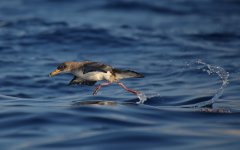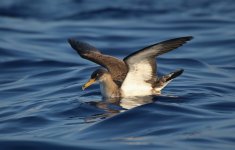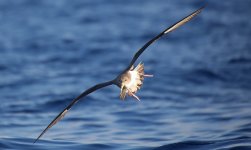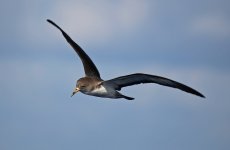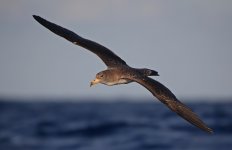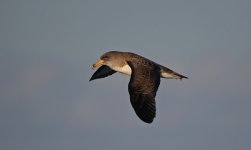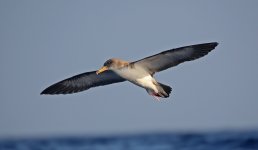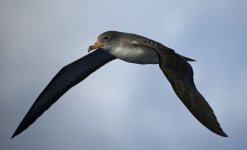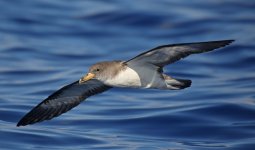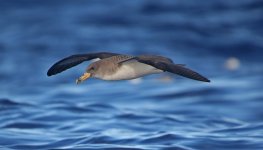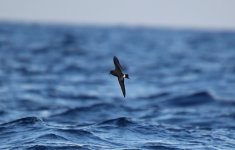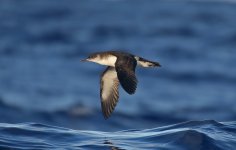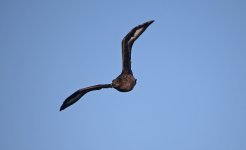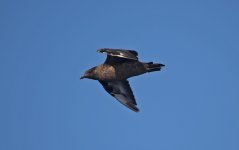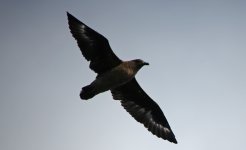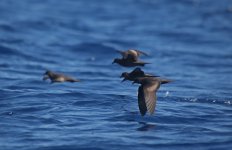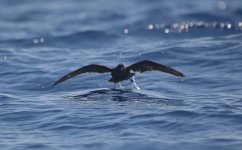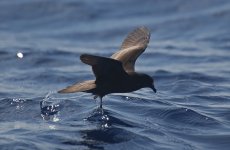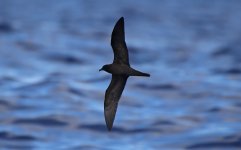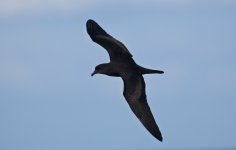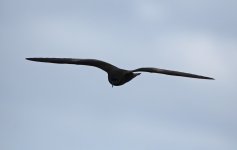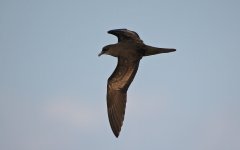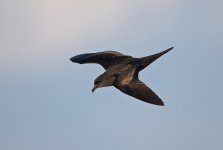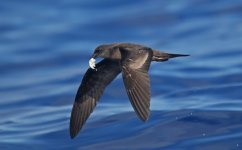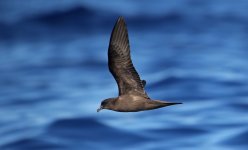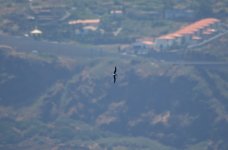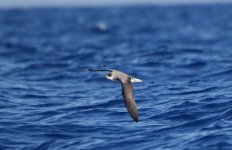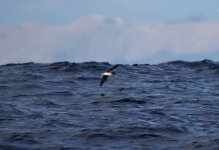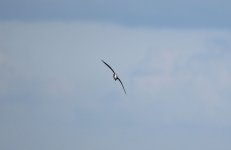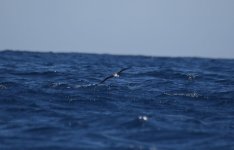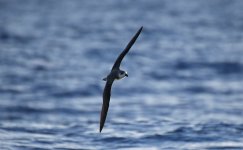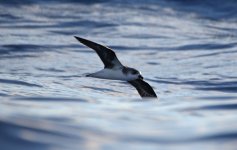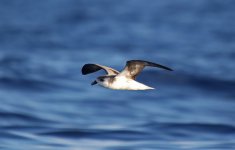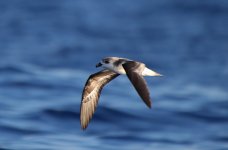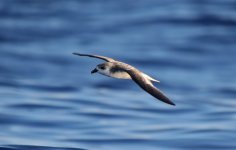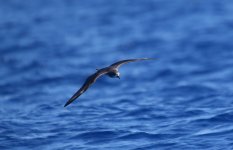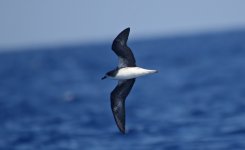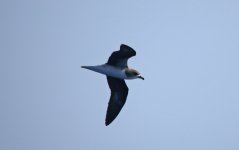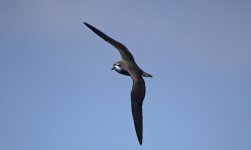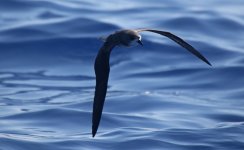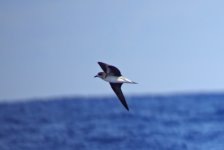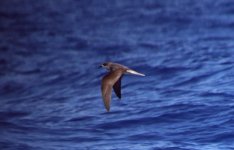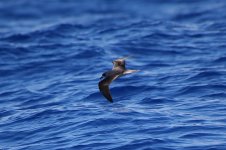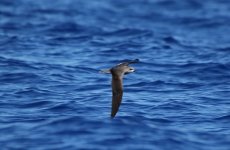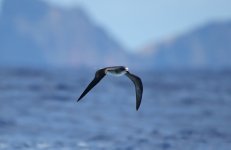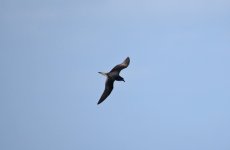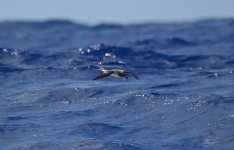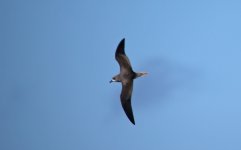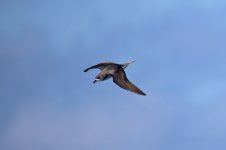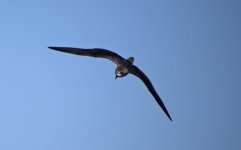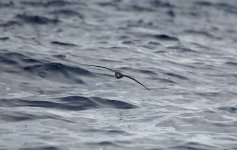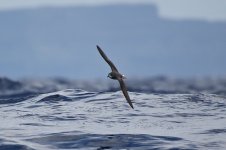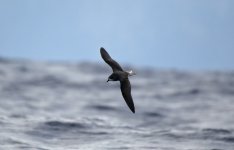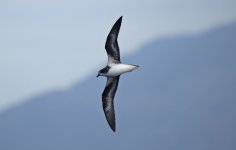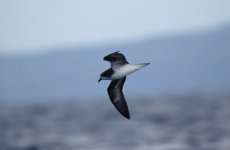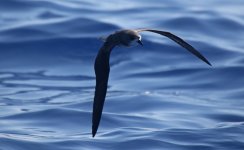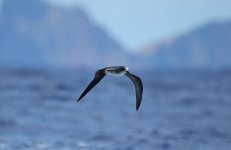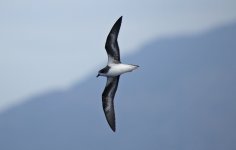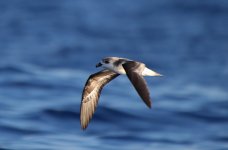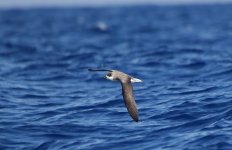Paul Chapman
Well-known member
With previous visits to the Canaries twice and Cape Verde, I had been trying to fit in a trip to Madeira for the last couple of years with some obvious Atlantic Islands specialities left to see but had always failed to make the arrangements to coincide my availability with pelagic availability.
As a result, when a friend mentioned a reasonably priced tour company trip that incorporated the usual triple Windbirds pelagics, I got it booked up nice and early so I wouldn’t need to worry about the previous years’ failed logistics.
Accommodation was in Santa Cruz within walking distance of the coast just south of the airport. Actually, if you walked inland, it was quite a nice wooded valley. Sadly, with a heavy workload before the trip, I spent most time relaxing save for the organised outings. A bit of a wasted opportunity but then again, the variety on Madeira is pretty limited so little was missed.
We arrived late morning on Monday 2nd July and left late morning on Friday 6th July. Around the accommodation, the commonest local species were immediately obvious being Yellow-legged Gull, Feral Pigeon, Plain Swift, Kestrel, Blackcap, Blackbird & Grey Wagtail. During lunch, Collared Dove and Canary were seen for the first time.
On the first day after lunch, Catarina and Hugo from Windbirds took us around a collection of the usual sites. At a coastal watchpoint, we saw Berthelot’s Pipit, Rock Sparrow and Red-legged Partridge and our first Common Terns were offshore. We headed up into the laurel forest and added Buzzard, Robin, Chaffinch, Greenfinch, Siskin and most importantly Madeiran Firecrest. Finally, a trip to the coast added Mallard, Muscovy, Moorhen, Little Egret and Common Waxbill. A quick look offshore produced our first Cory’s Shearwaters there. Off the resort early evening, a further group of Cory’s Shearwaters was feeding in the vicinity of a pod of dolphins offshore.
After dinner, at dusk, we set off for the middle of the island. It took about 40 minutes to arrive at the visitor’s centre. The walk out to the ridge above the Zino’s breeding colony took about thirty minutes in the dark and was pretty constant up and down. After a bit of a wait, at least ten were heard with Catarina pointing out the differences between male and female vocalisations. A Manx Shearwater and a Barn Owl were also heard. A late night before we arrived back at our accommodation at around 1.00am.
After breakfast the next morning, we again were collected. The first stop yielded the hoped for Trocaz Pigeon with at least four seen in a wooded valley above Funchal. The only other addition was a male Sparrowhawk but the usual supporting species were pretty constant and Madeiran Firecrest was heard. A trip to the coast produced a group of Roseate Terns mixed in with Common Terns and a flyby Grey Heron and at another site, a family party of Spectacled Warblers were seen. Again, Plain Swifts were pretty constant and Canary was seen on the coast as well as Buzzard.
After lunch, the main business began which was the first pelagic. At around 3.00pm, we headed east out of Machico to a position to the south of the Desertas. Basically, we travelled quite hard for two hours before chumming for several hours and then heading back to arrive in harbour after dark around 10.30pm. These were the same timings for each of the three pelagics.
The commonest species seen were Cory’s Shearwaters that were ever present together with at least 100 Bulwer’s Petrels. We had five Pterodroma sightings. All were considered to be Desertas Petrels. Two were seen quite close with a small-billed bird which nevertheless ‘felt’ like a large bird. It has remained the subject of some debate even when the photographs were considered but it was still considered Desertas by those who know these species pair best. The other close bird had a massive chunky bill and was a classic Desertas.
Supporting species were a Lesser Black-backed Gull amongst the Yellow-legged, a Great Skua harassing them, some Common Terns, Manx Shearwaters and two Madeiran Storm-petrels. The storm-petrels were the only ones seen on the whole trip and this was quite a disappointment. The previous week White-faced Storm-petrel and Wilson’s Storm-petrel had also been seen.
The next day was spent pottering around the resort in the morning before the second pelagic that afternoon. Again, the commonest species were present. A couple of Lovebirds heard in the town square but seen separately by others evaded identification – presumed escaped hybrids.
For the second pelagic, we headed to the north of Madeira and to the west of Porto Santo. A Dunlin on the seawall as we headed north was new. Again, the commonest species were Cory’s Shearwaters and Bulwer’s Petrels. We had seven Pterodroma sightings including two fleeting birds on which no probable identity was reached and three others were considered to be Desertas. One of those was a nice close bird with an abnormal amount of white on the underwing but a very large bill. We also saw two Zino’s Petrels of which one was relatively fleeting but the first gave a relatively good show close to the boat as it swung in around the front, along the side, twisted back on itself behind us and then headed away across the front. It had a dark underwing but immediately felt like a different species from those seen previously. On consideration of the photos, all agreed that it was a Zino’s. Although more distant and brief whilst we were travelling, the second was also a small bird. Other sightings again included Great Skua, Common Terns and Manx Shearwaters. On the way back, a pod of Atlantic Spotted Dolphins showed very close riding the bow and criss-crossing under the boat.
The final day followed the same regime and was spent pottering around the resort before the third and final pelagic. Again, we headed to the same area as the day before. The Dunlin was still present and again, many Cory’s Shearwaters and Bulwer’s Petrels entertained us. We had seven Pterodroma sightings with the same mix - two fleeting birds on which no probable identity was reached and three Desertas. Both Zino’s Petrels seen showed better than yesterday – one had a relatively dark underwing and one had a classic whitish underwing. Both were photographed. Other sightings again included Great Skua, Common Terns and Manx Shearwaters.
The final day and I was finally feeling lively enough to get up and out early so instead of turning down the hill to the resort, I headed up the valley on foot for a mile or so. The culvert held the usual Mallard, Muscovy and Moorhen together with many Grey Wagtails. The valley itself had a family party of Trocaz Pigeon, Buzzard and Chaffinch in addition to the Canaries and the usual common species. If I had had a little longer, I expect that I would have found Madeiran Firecrest there as well. I was disappointed with myself for not exploring the area earlier in the trip but sadly, it was time to pack and head to the airport.
Species List
Mallard – three sightings of up to two birds on 2nd, 5th and 6th July all showing signs of domestication…….
Muscovy Duck – apparent feral species – seen daily with up to fifteen birds along the culverts in Santa Cruz and Machico with birds occupying nest sites along the walls.
Red-legged Partridge – introduced and only persisting due to further introductions for hunting – single on the afternoon of 2nd July.
Zino's Petrel – endemic species – monotypic – at least ten heard at the breeding colony above Funchal on the evening of 2nd July; two seen on the second pelagic on 4th July of which one photographed; and two seen on the third pelagic on 5th July – both photographed.
Desertas Petrel – endemic species – monotypic – five seen on the first pelagic on 3rd July with four birds photographed including a controversial small-billed bird and a very large-billed bird; three seen on the second pelagic on 4th July all photographed; and three seen on the third pelagic on 5th July – two photographed.
Unidentified Pterodromas – two brief birds on both the second and third pelagics were not even identified to a probable species. As a result, the total number of pterodroma sightings from three pelagics was nineteen.
Bulwer's Petrel – around 100 seen on each of the three pelagics.
Cory's Shearwater – constantly present offshore and several hundred seen on each of the three pelagics.
Manx Shearwater – single heard at the Zino’s colony in the evening on 2nd July with two seen on the first pelagic on 2nd July and three seen on both the second and third pelagics on 3rd and 4th July.
Band-rumped Storm-Petrel – two seen on the first pelagic on 3rd July.
Grey Heron – single seen along the coast in the morning on 3rd July.
Little Egret – single seen in the culvert at Machico on 2nd, 3rd and 4th July.
Eurasian Sparrowhawk – endemic subspecies shared with the Canaries – single apparent male seen in a valley above Funchal in the morning on 3rd July.
Common Buzzard – nominate subspecies – at least two seen on 2nd July and one on 3rd July with two along the valley above the hotel in Santa Cruz on 6th July.
Eurasian Moorhen – nominate subspecies – apparently common in the urban culverts with sightings on four dates including of three recently fledged chicks in Santa Cruz.
Dunlin – a single summer-plumaged adult seen roosting on the seawall heading north out of Machico for the pelagics on 4th and 5th July.
Great Skua – monotypic – at least one seen on each of the pelagics on 3rd, 4th and 5th July with at least two different birds involved.
Yellow-legged Gull – ‘atlantis’ subspecies – very common with a reasonable number of juveniles seen.
Lesser Black-backed Gull – unsure of subspecific identity but presumably a graellsii/intermedius – a near-adult on the first pelagic on 3rd July.
Roseate Tern – nominate subspecies – at least fourteen seen on the morning of 3rd July.
Common Tern – nominate subspecies – seen on all bar the last day along the coastline and on all three pelagics.
Rock Dove – mainly Feral Pigeon candidates seen daily in good numbers.
Trocaz Pigeon – endemic species – monotypic – four seen above Funchal on 3rd July and another four seen up the valley from the hotel in Santa Cruz on 6th July.
Eurasian Collared-Dove – nominate subspecies – several seen on 2nd July.
Lovebird species – heard in the town square at Santa Cruz on 4th and 5th July but not seen. Considered to be hybrids when seen by others.
Barn Owl – endemic subspecies – single heard at the Zino’s colony above Funchal on the evening of 2nd July. (One was also seen but not by me in Santa Cruz on the evening of 3rd July.)
Plain Swift – monotypic – up to thirty seen daily. Pallid Swifts do occur but none were considered to have been seen by me…….
Eurasian Kestrel – endemic subspecies shared with central and western Canaries – seen daily.
Madeira Firecrest – endemic species – monotypic – seen on 2nd July and heard on 3rd July.
Eurasian Blackcap – endemic subspecies shared with the Canaries – regularly heard and occasionally seen.
Spectacled Warbler – endemic subspecies shared with the other Atlantic islands – at least four seen on the morning of 3rd July.
European Robin – nominate subspecies – single seen on 2nd July.
Eurasian Blackbird – endemic subspecies shared with the Canaries – very common and seen daily.
Grey Wagtail – endemic subspecies – very common and seen daily apparently filling lots of niches as a result of a lack of competitors.
Berthelot's Pipit – endemic subspecies – at least two seen on the afternoon of 2nd July.
Common Chaffinch – endemic subspecies – seen on the afternoon of 2nd July and heard on 3rd and 6th July.
European Greenfinch – subspecies shared with southern Europe – several seen on 2nd July.
Canary – monotypic – at least ten encountered on 2nd July, seen on the coast on 3rd July and in the valley at Santa Cruz on 6th July.
Eurasian Siskin – monotypic – single flew over on 2nd July.
Rock Sparrow – controversial endemic subspecies shared with Canaries – at least four seen on the afternoon of 2nd July.
Common Waxbill – introduced – at least eight seen on the afternoon of 2nd July.
Breeding species not recorded – Macronesian Shearwater (a winter breeder), Quail, Little Ringed Plover, Kentish Plover, Turtle Dove, Pallid Swift, Spanish Sparrow, Goldfinch & Linnet (endemic subspecies). I did not visit any wetland sites.
Other wildlife seen included Loggerhead Turtles on all three pelagics, a pod of dolphins off Santa Cruz on 2nd July that looked like Bottlenose Dolphin to me, a pod of Atlantic Spotted Dolphins on 4th July, Madeiran Wall Lizards, Perez’s Frog and a few lepidoptera including Monarch, Lang’s Short-tailed Blue, Madeiran Grayling, Rush Veneer and Duponchelia fovealis.
A few pics attached – the boat (if you go wear some waterproofs even if you feel daft putting them on standing next to sunbathers), Desertas and Bugio (as seen from the first pelagic), Madeira (looking back from the third pelagic), Loggerhead Turtle and a green Madeiran Wall Lizard (they were everywhere).
All the best
Paul
As a result, when a friend mentioned a reasonably priced tour company trip that incorporated the usual triple Windbirds pelagics, I got it booked up nice and early so I wouldn’t need to worry about the previous years’ failed logistics.
Accommodation was in Santa Cruz within walking distance of the coast just south of the airport. Actually, if you walked inland, it was quite a nice wooded valley. Sadly, with a heavy workload before the trip, I spent most time relaxing save for the organised outings. A bit of a wasted opportunity but then again, the variety on Madeira is pretty limited so little was missed.
We arrived late morning on Monday 2nd July and left late morning on Friday 6th July. Around the accommodation, the commonest local species were immediately obvious being Yellow-legged Gull, Feral Pigeon, Plain Swift, Kestrel, Blackcap, Blackbird & Grey Wagtail. During lunch, Collared Dove and Canary were seen for the first time.
On the first day after lunch, Catarina and Hugo from Windbirds took us around a collection of the usual sites. At a coastal watchpoint, we saw Berthelot’s Pipit, Rock Sparrow and Red-legged Partridge and our first Common Terns were offshore. We headed up into the laurel forest and added Buzzard, Robin, Chaffinch, Greenfinch, Siskin and most importantly Madeiran Firecrest. Finally, a trip to the coast added Mallard, Muscovy, Moorhen, Little Egret and Common Waxbill. A quick look offshore produced our first Cory’s Shearwaters there. Off the resort early evening, a further group of Cory’s Shearwaters was feeding in the vicinity of a pod of dolphins offshore.
After dinner, at dusk, we set off for the middle of the island. It took about 40 minutes to arrive at the visitor’s centre. The walk out to the ridge above the Zino’s breeding colony took about thirty minutes in the dark and was pretty constant up and down. After a bit of a wait, at least ten were heard with Catarina pointing out the differences between male and female vocalisations. A Manx Shearwater and a Barn Owl were also heard. A late night before we arrived back at our accommodation at around 1.00am.
After breakfast the next morning, we again were collected. The first stop yielded the hoped for Trocaz Pigeon with at least four seen in a wooded valley above Funchal. The only other addition was a male Sparrowhawk but the usual supporting species were pretty constant and Madeiran Firecrest was heard. A trip to the coast produced a group of Roseate Terns mixed in with Common Terns and a flyby Grey Heron and at another site, a family party of Spectacled Warblers were seen. Again, Plain Swifts were pretty constant and Canary was seen on the coast as well as Buzzard.
After lunch, the main business began which was the first pelagic. At around 3.00pm, we headed east out of Machico to a position to the south of the Desertas. Basically, we travelled quite hard for two hours before chumming for several hours and then heading back to arrive in harbour after dark around 10.30pm. These were the same timings for each of the three pelagics.
The commonest species seen were Cory’s Shearwaters that were ever present together with at least 100 Bulwer’s Petrels. We had five Pterodroma sightings. All were considered to be Desertas Petrels. Two were seen quite close with a small-billed bird which nevertheless ‘felt’ like a large bird. It has remained the subject of some debate even when the photographs were considered but it was still considered Desertas by those who know these species pair best. The other close bird had a massive chunky bill and was a classic Desertas.
Supporting species were a Lesser Black-backed Gull amongst the Yellow-legged, a Great Skua harassing them, some Common Terns, Manx Shearwaters and two Madeiran Storm-petrels. The storm-petrels were the only ones seen on the whole trip and this was quite a disappointment. The previous week White-faced Storm-petrel and Wilson’s Storm-petrel had also been seen.
The next day was spent pottering around the resort in the morning before the second pelagic that afternoon. Again, the commonest species were present. A couple of Lovebirds heard in the town square but seen separately by others evaded identification – presumed escaped hybrids.
For the second pelagic, we headed to the north of Madeira and to the west of Porto Santo. A Dunlin on the seawall as we headed north was new. Again, the commonest species were Cory’s Shearwaters and Bulwer’s Petrels. We had seven Pterodroma sightings including two fleeting birds on which no probable identity was reached and three others were considered to be Desertas. One of those was a nice close bird with an abnormal amount of white on the underwing but a very large bill. We also saw two Zino’s Petrels of which one was relatively fleeting but the first gave a relatively good show close to the boat as it swung in around the front, along the side, twisted back on itself behind us and then headed away across the front. It had a dark underwing but immediately felt like a different species from those seen previously. On consideration of the photos, all agreed that it was a Zino’s. Although more distant and brief whilst we were travelling, the second was also a small bird. Other sightings again included Great Skua, Common Terns and Manx Shearwaters. On the way back, a pod of Atlantic Spotted Dolphins showed very close riding the bow and criss-crossing under the boat.
The final day followed the same regime and was spent pottering around the resort before the third and final pelagic. Again, we headed to the same area as the day before. The Dunlin was still present and again, many Cory’s Shearwaters and Bulwer’s Petrels entertained us. We had seven Pterodroma sightings with the same mix - two fleeting birds on which no probable identity was reached and three Desertas. Both Zino’s Petrels seen showed better than yesterday – one had a relatively dark underwing and one had a classic whitish underwing. Both were photographed. Other sightings again included Great Skua, Common Terns and Manx Shearwaters.
The final day and I was finally feeling lively enough to get up and out early so instead of turning down the hill to the resort, I headed up the valley on foot for a mile or so. The culvert held the usual Mallard, Muscovy and Moorhen together with many Grey Wagtails. The valley itself had a family party of Trocaz Pigeon, Buzzard and Chaffinch in addition to the Canaries and the usual common species. If I had had a little longer, I expect that I would have found Madeiran Firecrest there as well. I was disappointed with myself for not exploring the area earlier in the trip but sadly, it was time to pack and head to the airport.
Species List
Mallard – three sightings of up to two birds on 2nd, 5th and 6th July all showing signs of domestication…….
Muscovy Duck – apparent feral species – seen daily with up to fifteen birds along the culverts in Santa Cruz and Machico with birds occupying nest sites along the walls.
Red-legged Partridge – introduced and only persisting due to further introductions for hunting – single on the afternoon of 2nd July.
Zino's Petrel – endemic species – monotypic – at least ten heard at the breeding colony above Funchal on the evening of 2nd July; two seen on the second pelagic on 4th July of which one photographed; and two seen on the third pelagic on 5th July – both photographed.
Desertas Petrel – endemic species – monotypic – five seen on the first pelagic on 3rd July with four birds photographed including a controversial small-billed bird and a very large-billed bird; three seen on the second pelagic on 4th July all photographed; and three seen on the third pelagic on 5th July – two photographed.
Unidentified Pterodromas – two brief birds on both the second and third pelagics were not even identified to a probable species. As a result, the total number of pterodroma sightings from three pelagics was nineteen.
Bulwer's Petrel – around 100 seen on each of the three pelagics.
Cory's Shearwater – constantly present offshore and several hundred seen on each of the three pelagics.
Manx Shearwater – single heard at the Zino’s colony in the evening on 2nd July with two seen on the first pelagic on 2nd July and three seen on both the second and third pelagics on 3rd and 4th July.
Band-rumped Storm-Petrel – two seen on the first pelagic on 3rd July.
Grey Heron – single seen along the coast in the morning on 3rd July.
Little Egret – single seen in the culvert at Machico on 2nd, 3rd and 4th July.
Eurasian Sparrowhawk – endemic subspecies shared with the Canaries – single apparent male seen in a valley above Funchal in the morning on 3rd July.
Common Buzzard – nominate subspecies – at least two seen on 2nd July and one on 3rd July with two along the valley above the hotel in Santa Cruz on 6th July.
Eurasian Moorhen – nominate subspecies – apparently common in the urban culverts with sightings on four dates including of three recently fledged chicks in Santa Cruz.
Dunlin – a single summer-plumaged adult seen roosting on the seawall heading north out of Machico for the pelagics on 4th and 5th July.
Great Skua – monotypic – at least one seen on each of the pelagics on 3rd, 4th and 5th July with at least two different birds involved.
Yellow-legged Gull – ‘atlantis’ subspecies – very common with a reasonable number of juveniles seen.
Lesser Black-backed Gull – unsure of subspecific identity but presumably a graellsii/intermedius – a near-adult on the first pelagic on 3rd July.
Roseate Tern – nominate subspecies – at least fourteen seen on the morning of 3rd July.
Common Tern – nominate subspecies – seen on all bar the last day along the coastline and on all three pelagics.
Rock Dove – mainly Feral Pigeon candidates seen daily in good numbers.
Trocaz Pigeon – endemic species – monotypic – four seen above Funchal on 3rd July and another four seen up the valley from the hotel in Santa Cruz on 6th July.
Eurasian Collared-Dove – nominate subspecies – several seen on 2nd July.
Lovebird species – heard in the town square at Santa Cruz on 4th and 5th July but not seen. Considered to be hybrids when seen by others.
Barn Owl – endemic subspecies – single heard at the Zino’s colony above Funchal on the evening of 2nd July. (One was also seen but not by me in Santa Cruz on the evening of 3rd July.)
Plain Swift – monotypic – up to thirty seen daily. Pallid Swifts do occur but none were considered to have been seen by me…….
Eurasian Kestrel – endemic subspecies shared with central and western Canaries – seen daily.
Madeira Firecrest – endemic species – monotypic – seen on 2nd July and heard on 3rd July.
Eurasian Blackcap – endemic subspecies shared with the Canaries – regularly heard and occasionally seen.
Spectacled Warbler – endemic subspecies shared with the other Atlantic islands – at least four seen on the morning of 3rd July.
European Robin – nominate subspecies – single seen on 2nd July.
Eurasian Blackbird – endemic subspecies shared with the Canaries – very common and seen daily.
Grey Wagtail – endemic subspecies – very common and seen daily apparently filling lots of niches as a result of a lack of competitors.
Berthelot's Pipit – endemic subspecies – at least two seen on the afternoon of 2nd July.
Common Chaffinch – endemic subspecies – seen on the afternoon of 2nd July and heard on 3rd and 6th July.
European Greenfinch – subspecies shared with southern Europe – several seen on 2nd July.
Canary – monotypic – at least ten encountered on 2nd July, seen on the coast on 3rd July and in the valley at Santa Cruz on 6th July.
Eurasian Siskin – monotypic – single flew over on 2nd July.
Rock Sparrow – controversial endemic subspecies shared with Canaries – at least four seen on the afternoon of 2nd July.
Common Waxbill – introduced – at least eight seen on the afternoon of 2nd July.
Breeding species not recorded – Macronesian Shearwater (a winter breeder), Quail, Little Ringed Plover, Kentish Plover, Turtle Dove, Pallid Swift, Spanish Sparrow, Goldfinch & Linnet (endemic subspecies). I did not visit any wetland sites.
Other wildlife seen included Loggerhead Turtles on all three pelagics, a pod of dolphins off Santa Cruz on 2nd July that looked like Bottlenose Dolphin to me, a pod of Atlantic Spotted Dolphins on 4th July, Madeiran Wall Lizards, Perez’s Frog and a few lepidoptera including Monarch, Lang’s Short-tailed Blue, Madeiran Grayling, Rush Veneer and Duponchelia fovealis.
A few pics attached – the boat (if you go wear some waterproofs even if you feel daft putting them on standing next to sunbathers), Desertas and Bugio (as seen from the first pelagic), Madeira (looking back from the third pelagic), Loggerhead Turtle and a green Madeiran Wall Lizard (they were everywhere).
All the best
Paul




